 The Nine Pearls, sometimes known as the Nava Moti (or nine gems, or “mani”), are a group of sacred gemstones described in the Vedic text known as the Garuda Purana. Enumerated as the Oyster Pearl, Conch Pearl, Cobra Pearl, Boar Pearl, Elephant Pearl, Bamboo Pearl, Whale Pearl, Fish Pearl, and Cloud Pearl, these gems were later documented in the treatise Brihat-Samhita (“The Great Compilation”) of Varahamihira, the Indian mathematician.
The Nine Pearls, sometimes known as the Nava Moti (or nine gems, or “mani”), are a group of sacred gemstones described in the Vedic text known as the Garuda Purana. Enumerated as the Oyster Pearl, Conch Pearl, Cobra Pearl, Boar Pearl, Elephant Pearl, Bamboo Pearl, Whale Pearl, Fish Pearl, and Cloud Pearl, these gems were later documented in the treatise Brihat-Samhita (“The Great Compilation”) of Varahamihira, the Indian mathematician.
The first documented contact with these artifacts by the Western world is described in the sole volume of 18th Century scientist Albertus Seba, entitled Cabinet of Natural Curiosities. Therein, a large collection of Bezoar stones and non-oyster pearls were hand-sketched, and the collection of these items were on display in a forum which was the precursor of the modern day museum. Today, the original 446-plate volume, part of the greater work Locupletissimi Rerum Naturalium Thesauri Accurata Descriptio, is on permanent exhibit at the Koninklijke Bibliotheek in The Hague, Netherlands.
Shankha Mani: Conch Pearl
 A Conch Pearl is formed rarely within the digestive tract of any of a wide variety of species within the greater Conch family. The colors vary from white to pink to yellow to a deep reddish tone. The shapes vary greatly, and no two Conch Pearls are alike, making a matching pair an exceeding difficulty (and expensive) proposition. It is presently impossible to cultivate a Conch Pearl as the formation is not nacre, but an intestinal deposit making the gem most closely fall into the category of bezoar stone. It is very difficult to find a round Conch pearl, or any Conch pearl above 2 carats (400 mg).
A Conch Pearl is formed rarely within the digestive tract of any of a wide variety of species within the greater Conch family. The colors vary from white to pink to yellow to a deep reddish tone. The shapes vary greatly, and no two Conch Pearls are alike, making a matching pair an exceeding difficulty (and expensive) proposition. It is presently impossible to cultivate a Conch Pearl as the formation is not nacre, but an intestinal deposit making the gem most closely fall into the category of bezoar stone. It is very difficult to find a round Conch pearl, or any Conch pearl above 2 carats (400 mg).
The Garuda Purana states in Chapter LXIX (69) “Pearls found… in the entrails of conch-shells, are devoid of lustre, though possessed of other auspicious virtues. Of the eight species of pearls described by the conoisseurs of gems, those obtained from conch shells and the temple of elephants should be deemed as standing in the bottom of the list as regards colour and brilliancy. A conch shell pearl is usually as big as a large Kona (point of rapier) and assumes a color similar to that of the mollusk it is found in.”
Varahamihira states in Brihat-Samhita, Chapter 51 “The pearl born of conch shell is round, lustrous, beautiful and moonlike… The pearls from conch shells… ought not to be perforated and as they possess inestimable virtues or excellences, no price has been fixed for them by the authorities.”
Naga Mani: Cobra Pearl
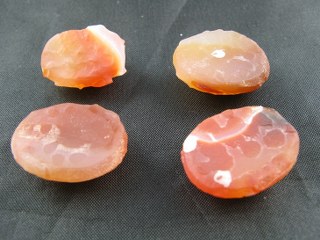 Cobra Pearls are typically egg-shaped and translucent, transparent, or semi-translucent; roughly 2 cm length, 2 cm diameter and weighing about 5 grams, appearing in a range of colors (golden, green, red, blue, pink, white, black).
Cobra Pearls are typically egg-shaped and translucent, transparent, or semi-translucent; roughly 2 cm length, 2 cm diameter and weighing about 5 grams, appearing in a range of colors (golden, green, red, blue, pink, white, black).
The Garuda Purana states in Chapter LXIX (69) “A pearl found in the hood of a cobra is round in shape like the one obtained from the mouth of a fish and emits a dazzling effulgence from its own natural seat. After copious washing such a pearl assumes the lustre of a well-polished sword. The possessor of a cobra or serpent pearl meets with rare good fortune, and becomes a pious and illustrious king in time, with a treasury full of other species of precious gems. Dark clouds, hung down and heavily charged with rain, and roaring with the voice of the eternal trumpets blown upon at the time of universal dissolution and spangled with flashes of lightning, closely envelop the sky, at the time, when the Bramhana, well versed in the religious and ceremonial proceedings, after inquiring about the acquisition of such a pearl, and having done the necessary rite of protection unto it, formally takes it into the interior of the house of its possessor. Neither the serpents, nor the Rakshas (a type of demon), nor diseases, nor disturbances of any kind would assail the man amidst whose treasure such a snake pearl would lie.”
Varahamihira states in Brhat Samhita, Chapter 51 “The serpents of the lineage of Taksaka and Vasuki and those that move at will, have bright, blue-tinged pearls on their hoods. If Indra suddenly rains on a blessed spot of the earth and into a silver vessel, it should be recognized as a pearl coming from the serpents…
A pearl born of the serpents, being worn by kings, will prove invaluable to them, destroy their misfortune and enemies, enhance their reputation and bestow victory…
It is said that on the head of serpents there is a gem with the hue of a bee or peacock’s neck, and shining like the flame of a lamp. Such a gem is to be known as of inestimable value. A king who wears such a serpent-gem will never have troubles arising from poison and diseases. Indra will always be pouring good rains in his realm, and as a result of the intrinsic power of the gem he will annihilate his enemies.”
Varaha Mani: Boar Pearl
 A Boar Pearl is typically dark colored, marble-sized, in an uneven but smooth spherical non-porous surface, both opaque and partially translucent.
A Boar Pearl is typically dark colored, marble-sized, in an uneven but smooth spherical non-porous surface, both opaque and partially translucent.
The Garuda Purana states in Chapter LXIX (69) “Pearls are found in the temples of elephants and wild boars… A boar pearl resembles the tip of its tusk in color, and is obtained in certain quarters of the globe and is blissful like the boar incarnation of the divine Vishnu.
Varahamihira states in Brihat-Samhita, Chapter 51, “Very valuable and lustrous like the Moon is the pearl born of the root of the boar’s tusks… (they) possess inestimable virtues or excellences, no price has been fixed for them by the authorities.”
Gaja Mani: Elephant Pearl
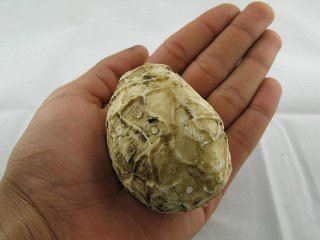 Some varieties of Elephant Pearl are made up of a heavy dark brown substrate, while others are heavy balls, of varying colors, about the size of a Brain Coral, often with a hemispheric division.
Some varieties of Elephant Pearl are made up of a heavy dark brown substrate, while others are heavy balls, of varying colors, about the size of a Brain Coral, often with a hemispheric division.
The Garuda Purana states in Chapter LXIX (69) “Pearls found… in the temples of elephants and wild boars or in the mouths of whales or in the entrails of conch-shells, are devoid of lustre, though possessed of other auspicious virtues… Of the eight species of pearls described by the conoisseurs of gems, those obtained from conch shells and the temple of elephants should be deemed as standing in the bottom of the list as regards colour and brilliancy. A pearl found in the temple of an elephant is marked by the absence of any definite colour and is lustreless like a pearl found in the stem of a bamboo.
Varahamihira states in Brihat-Samhita, Chapter 51 “The elephants that are born in the winter solstice (uttara-yapa) during an eclipse of the Sun or the Moon are named Bhadra. It is said that pearls are produced in the heads and in the sockets of the tusks of elephants of Airavata’s family at the Moon’s conjunction with the asterism Pusya or Sravana synchronous with a Sunday or Monday, as well as of the Bhadra class of elephants. These pearls are numerous, large, brilliant, and of various shapes. These are beyond any estimate and should not be perforated, being too brilliant. When they are worn by kings, they prove highly sanctifying and bestow children, victory, and sound health.
Bamboo Pearls
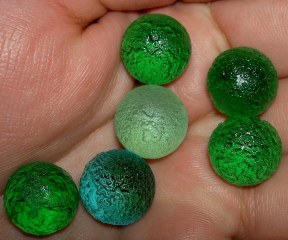 Bamboo Pearls are round or oblong, heavy, some off-white, rough and dry, resembling camphor crystals in color and texture, others are golden or a flowing green reminiscent of other minerals. They are between the size of a large marble and the upper joint of the thumb, with symmetrical markings.
Bamboo Pearls are round or oblong, heavy, some off-white, rough and dry, resembling camphor crystals in color and texture, others are golden or a flowing green reminiscent of other minerals. They are between the size of a large marble and the upper joint of the thumb, with symmetrical markings.
The Garuda Purana states in Chapter LXIX (69) “Pearls found in the stems of bamboos… are devoid of lustre, though possessed of other auspicious virtues. A pearl obtained from inside the hollow stem of a bamboo resembles a hailstone in color, and is found only in bamboo that grows in the land of the honest and the pious, and not in every type of that grass.
Mahopanishad from the Samaveda VI-15(b)-16 states “Magnanimous one! Flawless cognitions swiftly fly to him who finds himself in his last birth, just as pure pearls lodge themselves in the best bamboo.”
Varahamihira states in Brihat-Samhita, Chapter 51 “A pearl is to be known to have sprung from bamboo if it resembles camphor or crystal and is flat and uneven (or rough) they are considered extremely valuable and bestow sons, wealth, popularity, renown, and destroy disease, grief, while bestowing objects of desire upon kings.
Whale Pearls
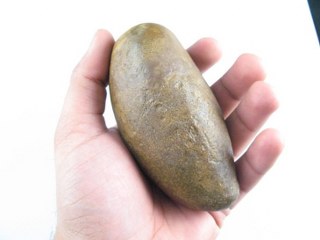 Whale Pearls are rough-textured in a variegated pattern formation, moderately translucent, and about the size of a small egg. Several types of Whale Pearl have been observed, varying in texture.
Whale Pearls are rough-textured in a variegated pattern formation, moderately translucent, and about the size of a small egg. Several types of Whale Pearl have been observed, varying in texture.
The Garuda Purana states in Chapter LXIX (69) “Pearls found in the stems of bamboos or in the temples of elephants and wild boars or in the mouths of whales or in the entrails of conch-shells, are devoid of lustre, though possessed of other auspicious virtues.
Varahamihira states in Brhat-Samhita, Chapter 51 “The pearls from whales resemble a fish’s eye, are large, pure, and of great value… the pearls from… whales… ought not to be perforated and as they possess inestimable virtues or excellences, no price has been fixed for them by the authorities.
Fish Pearls
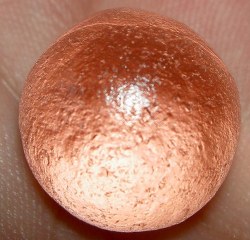 Fish Pearls are rough-textured with variegated pattern formations, moderately translucent, and about the size of a large marble. Several types of Fish Pearl have been observed, varying only in color (i.e. pink, white with a yellow-pink tint and light green with stratification) and texture.
Fish Pearls are rough-textured with variegated pattern formations, moderately translucent, and about the size of a large marble. Several types of Fish Pearl have been observed, varying only in color (i.e. pink, white with a yellow-pink tint and light green with stratification) and texture.
The Garuda Purana states in Chapter LXIX (69) “A pearl found in the mouth of a fish is a perfect sphere in shape and is marked by a yellowish hue, like the back of a pathenam fish as is occasionally found inside the mouth of a whale that frequents the unfathomable depths of ocean beds.
Cloud Pearls
Cloud Pearls are traditionally known as approximating the size and shape of a chicken egg, with a translucent blue color, and having a distinct spiral running from bottom to top of outside surface area.
The Garuda Purana states in Chapter LXIX (69) “A cloud-grown pearl rarely reaches this mortal globe, and usually falls to the lot of the celestials.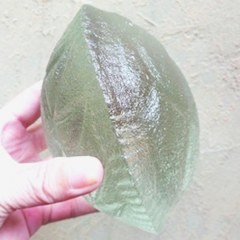 By illuminating the four quarters of the sky with its native lustre, a cloud-begotten pearl, like the sun dispels the gloom of a cloudy day. Outshining the combined effulgence of the fire, the moon, and the myriads of scintillating stars, such a pearl, like the dawn of day, can dispel the gloom of even the darkest night on earth.
By illuminating the four quarters of the sky with its native lustre, a cloud-begotten pearl, like the sun dispels the gloom of a cloudy day. Outshining the combined effulgence of the fire, the moon, and the myriads of scintillating stars, such a pearl, like the dawn of day, can dispel the gloom of even the darkest night on earth.
The whole earth, girdled by the four oceans containing innumerable gems in the fathomless depths, can not be deemed as the adequate price of such a pearl, even if she be covered over with layers of pure gold. A man, born in indigence and of humble parents, but happening to be the possessor of such a pearl, only through the transformation of a good deed done in a previous existence, is sure to be the paramount sovereign of the entire surface of the Earth. Not to the good deeds of the king alone, but to the better fortune of the whole humanity, should be ascribed the advent of such a man on earth, and no evil would ever strike the land to the extent of a thousand Yojanas (a Yojana is about 8 to 9 miles) round the place of his birth.
Varahamihira states in Brhat-Samhita, Chapter 51 “They say that pearl is produced in the clouds of the seventh layer of wind in the sky in the manner of hail-stones. It falls there with the brilliance of lightning and is taken away (before it reaches the earth) by the denizens of heaven.